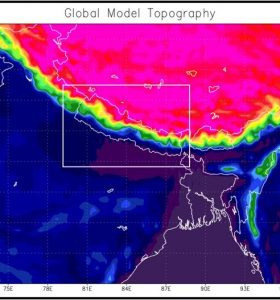Introduction
Supercomputing is powerful and is utilised primarily in the science, research and business sectors. ESS Weathertech (ESS) has been specialising in the supply of supercomputing systems for more than 10 years now through different projects that stretch internationally to countries including Nepal, Pakistan, and Bangladesh.
In this article, we will discuss the mechanics of supercomputing and its contribution to forecasting systems worldwide.
What is a Supercomputer?
A supercomputer is a large array of smaller computers and processing equipment that are aggregated to make one large computer. They are built for the purpose of solving problems too complex for an ordinary desktop or workstation to process. As such, supercomputers can reduce the time taken to solve problems to days rather than months.
Supercomputers are generally found in science, engineering, and business sectors to enhance the processing of complex problems. As a result, they utilise large amounts of computing power harnessed from each individual node. This method is typically referred to as High-Performance Computing (HPC). HPC can be used to run intricate models for forecasting the weather. This is commonly known as Numerical Weather Prediction (NWP) where weather data is processed by the computer for modelling purposes.
Components of a Supercomputer
The main guts of a supercomputer is the computer cluster. The cluster is where all the smaller computers are held, generally in a rack mount. Each different computer is referred to as a ‘node’. The nodes all have processors/cores like desktop computers, for instance, Intel or AMD. This is the brains of the computer which executes the instructions. The processing power can be measured in teraflops or petaflops (where a FLOPS is a floating-point operation). As a gauge, the processing power of an HPC, the National Weather Service in America are running supercomputers that operate at a total of 8.4 petaflops – 10,000 times faster than a regular desktop computer!*
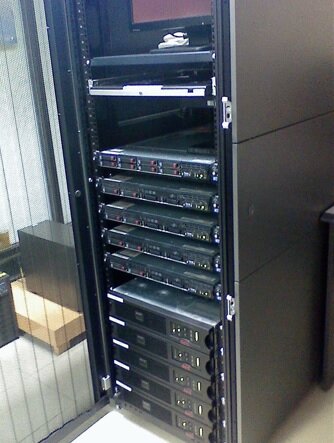
Each individual node “talks” to each other through a communications network. This can be done via an ‘InfiniBand’; a standard of networking communication in HPC that helps transfer data between computers with very high throughput and very low latency so that the links between the nodes doesn’t slow down the combined processing speed between nodes.
Other supercomputer components include monitors, keyboards, power distribution, ethernet switches, and uninterruptible power supply (UPS). A UPS is important in case there is a power failure. Consequently, it ensures power is still provided to the supercomputer so the data is unharmed and processes continue to churn away while the system safely shuts down the supercomputer. If the supercomputer is not shutdown appropriately it can corrupt the data or the software which has catastrophic and costly consequences. All this equipment is normally stored in a rack mount (see Figure 1.) and in an environmentally controlled cool room.
Supercomputers and forecasting
For weather forecasting, and before the supercomputer processes data, the data needs to be obtained from somewhere. Devices such as radar, weather stations, satellite images, profilers, and other sensors measure different atmospheric parameters, collect data and send the data to a central database for storage (e.g. NAS – Network Attached Storage) that can then be used by the supercomputer. After that, they are sent to an archive for long term storage.
Installed on the hardware is software to process, analyse, and visualise the incoming data. This ranges from the basics of the Operating Software (e.g. Linux) to GNU compilers (e.g. Python, C++…), math, and data libraries (e.g. MATLAB, NetCDF4) to visualisation software like the Grid Analysis Display System (GrADS).
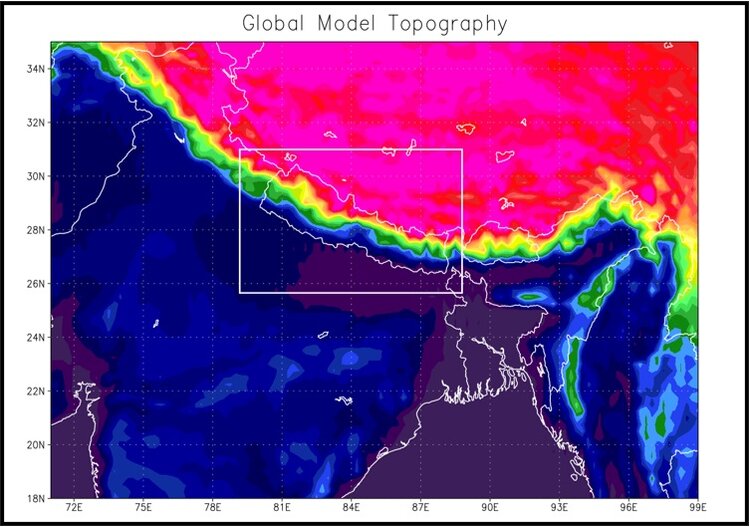
Numerical Weather Prediction (NWP)
NWP utilises supercomputing to calculate the equations that define the flow of fluids in the atmosphere and oceans. The supercomputer implements the method of NWP by translating the governing equations of dynamical meteorology, numerical methods, parameterized physical processes, and initial and boundary conditions into computer code which is then analysed and determined over a specific geographic domain (e.g. Nepal in Figure 2.).
Figure 3. depicts a simple flow chart of the essentials a modelling system (e.g. Weather Research and Forecast (WRF) model) would potentially progress through. NOTE: Figure 3. is one example data route of a much larger flow chart.
Firstly, data is collected from an external source – this may be observational data collected by a weather bureau (via satellite, radiosondes, weather stations, radar etc.) or this could be model data. This data is then put through pre-processing such as data assimilation. Data assimilation is a processing technique to estimate the optimal state of the evolving weather system by combining observational and numerical model data. Secondly, the data is run through the model calculations. Finally, the data is post-processed and visualised by software such as GrADS.
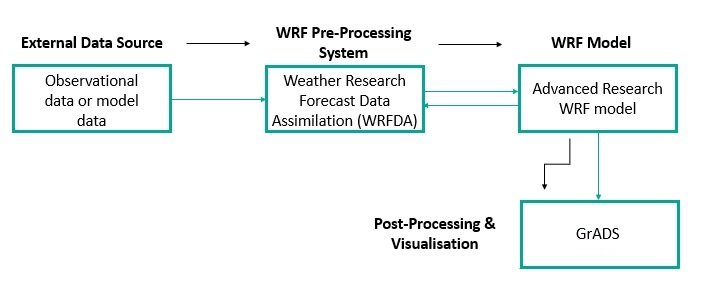
Furthermore, methods of NWP such as ensemble forecasting is used to improve current modelling techniques by producing more reliable and accurate forecasts. This is done by comparing various NWP forecasts and combining multiple models runs through statistical and graphical methods to reduce the level of uncertainty of the model outcomes and increase confidence in the accuracy of the final output.

Project History
ESS has been involved in several international HPC and NWP projects. ESS has extensive expertise working with these software solutions and similar packages, having installed similar modelling systems in Australia, the USA, Bangladesh, and Nepal.
Recently ESS installed a Weather Research and Forecast system in Pakistan for the National Meteorological Service (PMD). It was part of a project funded by the Government of Japan. ESS currently run the WRF model at the University of New South Wales Mathematics Department. They provide forecast guidance for a client base. A brief description of some of these projects follows:
Department of Hydrology and Meteorology (DHM), Nepal – HPC and NWP Project
ESS experts are currently delivering an NWP and HPC system for the Department of Hydrology and Meteorology, Nepal. This procurement is part of the investments of the Building Resilience to Climate Related Hazards (BRCH) project scheduled for the period 2013-2018. The BRCH project is one of the four projects funded through the Nepal Pilot program for Climate Resilience (PPCR) under the Strategic Climate Fund by the World Bank.
This procurement focuses on the high-performance computing system needed specifically to operate a mesoscale high-resolution atmospheric NWP model. Currently, the Weather Research and Forecast model suitable for providing localized weather and Quantitative Precipitation Forecasts is installed at DHM for test use.
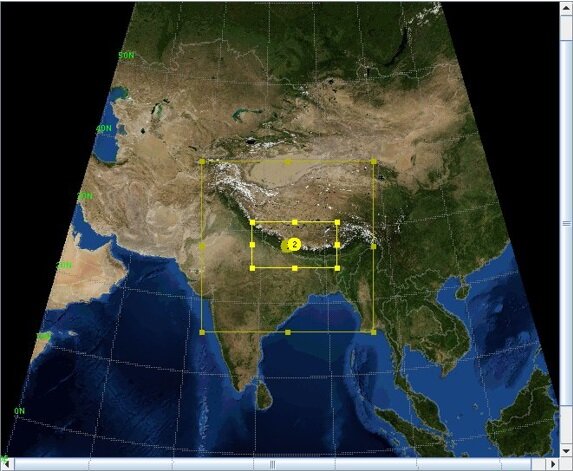
Pakistan Meteorological Department (PMD) Project
In 2019, ESS completed a three-year project tasked to design, build and deliver a turnkey for High-Performance Computing, including a Forecast Guidance System based on Numerical Weather Prediction data for the Specialized Medium Range Weather Forecasting Center (SMRFC) of the Pakistan Meteorological Department (PMD). This project was funded by the Government of Japan, and the focus is to enable the PMD for a more accurate and timely forecasting of severe weather including heavy rainfall and flooding. The accompanying Forecast Guidance System is based on the Objective Consensus Forecast (OCF) system which is tuned for Pakistan. It uses direct model output of standard meteorological parameters such as temperature, humidity, wind and rainfall from a suite of up to six global and regional models, weighs these according to model performance over Pakistan and produces consensus forecasts out to seven days for 100 towns and cities.
Bangladesh Meteorological Department (BMD) – NWP Project
ESS experts installed and commissioned an HPC supercomputer cluster running the Japan Meteorological Agency regional numerical model over a Bangladesh domain. This project was funded by the Government of Japan, and ESS was a sub-contractor for the provision of its experts to undertake the Numerical Weather Prediction scope of the work, which comprises of the following:
- Provision of Operation Software of the HPC Cluster for Numerical Weather Prediction Model (JMA Non-Hydrostatic Model)
- Installation and Adjustment of Operation Software for Numerical Weather Prediction Model
- Contents of Numerical Weather Prediction Model (JMA Non-Hydrostatic Model)
Summary
High-Performance Computing has the capacity to provide short term weather forecast by establishing an operational high-resolution local area Numerical Weather Prediction system to provide improved guidance for weather forecasting. Subsequently, they are a massive aid in the assessment of rapidly developing severe weather situations.
Outcomes of an operational HPC system include a platform to provide NWP leading to output such as quantitative precipitation forecasts (QPF) for flood forecasting. Therefore, increase lead time for flood warnings, improve alert services including severe weather and heavy monsoonal rain events, thunderstorms, and flood risks.
These abilities of an HPC are very beneficial to weather services and governmental weather bureaus around the globe. HPC and NWP are continually developing and improving globally to provide services to the public and private sectors.
For more information on HPC and NWP from our experts, please contact us via LinkedIn or our website essweathertech.com
References: *https://www.weather.gov/about/supercomputers
** https://www.weather.gov/media/ajk/brochures/NumericalWeatherPrediction.pdf


